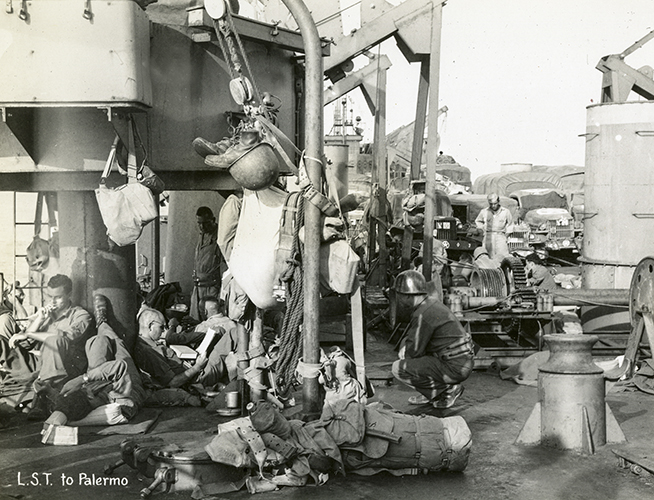Palermo, Sicily
During the night of August 5 we turned north from Cape Bon and sailed to the northwest of Sicily. We then headed east again sighting the Island of Sicily about 1:30 PM. It is quite an impressive sight to sight land while at sea where nothing has been visible on the horizon. At first glance a vague cloud-like area looms upon the horizon and it is often difficult to be sure whether it is a distant gray cloud or actually land.
We sailed along the northern coast all afternoon and at about 4 PM, after complete peace and unawareness of war, we were suddenly called to stations, donned our helmets and put on our life belts in order. We then suddenly changed course, the entire convoy circling north. A destroyer up ahead in our former path let go with depth charges. For almost an hour we zig-zagged and all aboard combed the smooth blue water for signs of a periscope or tell-tale wake of a torpedo. However, none were seen and we pointed our bow south to the beautiful harbor of Palermo, which had by this time come into view. I must confess I felt a little feeling of disappointment at the uneventfulness of what promised to be an exciting occasion.
We entered the harbor about dusk, and a new moon shone brightly behind the ascending barrage balloons, which look like numerous floating whales.
Due to the oncoming darkness it was difficult to get a complete view of the city itself. The coast at this point is indented to form an evenly curved crescent with a circumference of about 5 miles. The city is built along the shore of the crescent and the mountains rise abruptly in the background.
By the time we reached the inner harbor it was pitch black and our ship was obliged to creep into the dock at a snail’s pace. Here and there we were able to make out the masts and rigging of sunken ships standing out against the water-line in the reflection of the moonlight.
The town itself remained pitch black and appeared for all the world like a deserted village. Before it had become so completely dark, we had been able to make out the typical four-walled, hollow structures so characteristic of bombed buildings. These skeletons lined the entire waterfront and it was not difficult to see that they had once been beautiful buildings.
At times such as this, one cannot but help be grateful that our homes have thus far escaped such a fate and that our loved ones are safe from the terror, destruction and disappointment which these poor people have suffered.
At about 1:30 A.M. we leave the ship and travel through town in total darkness. We can barely discern piles of rubble and bomb craters in the street. Most of the buildings in the first 4 to 5 blocks adjacent to the waterfront have suffered heavy destruction. We spend the night in a lemon orchard amidst swarms of ants, making sleep almost impossible.
In the morning we find ourselves besieged by men and boys selling grapes, figs, watermelon, wine and haircuts.
.



